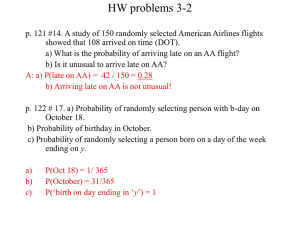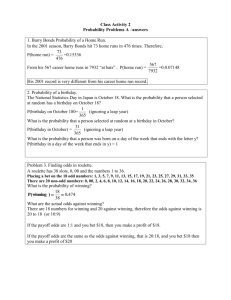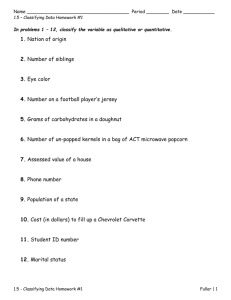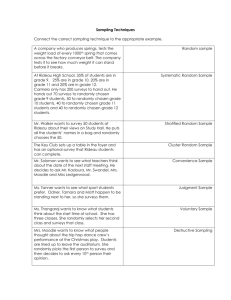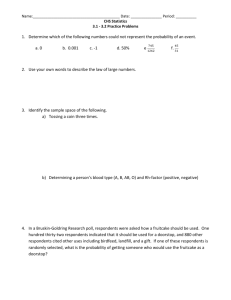Chapter 3 - Wells` Math Classes
advertisement
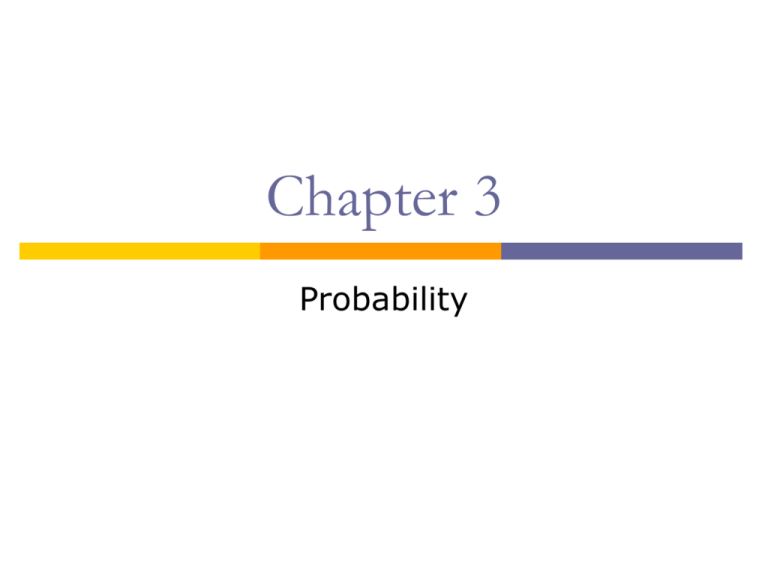
Chapter 3 Probability Every Day, each us makes decisions based on uncertainty. Should you buy an extended warranty for your new DVD player? It depends on the likelihood that it will fail during the warranty. Should you allow 45 min to get to 1st period or is 35 min enough? Lesson 3-1/3-2 Fundamentals Rare Event Rule If, under a given assumption (such as a lottery being fair), the probability of a particular observed event (such as five consecutive lottery wins) is extremely small, we conclude that the assumption is probably not correct Probability The probability of an event is the proportion of times the event is expected to occur in repeated experiments. Sample Space (S) The set of all possible outcomes of an event is the sample space S of the event. Example: For the event “roll a die and observe what number it lands on” the sample space contains all possible numbers the die could land on. S 1, 2,3, 4,5,6 Event An event is an outcome (or a set of outcomes) from a sample space Example 1: When flipping three coins, an event may be getting the result HTH. In this case, the event is one outcome from the sample space. Example 2: When flipping three coins, an event may be getting two tails. In this case, the event is a set of outcomes (HTT, TTH, THT, …) from the sample space An event is usually denoted by a capital letter. Example: Call getting two tails event A. The probability of event A is denoted P(A). Probability Properties P denotes probability The probability of an event, say event A, is denoted P(A). All probabilities are between 0 and 1. (i.e. 0 P ( A) 1 ) The sum of the probabilities of all possible outcomes must be 1. The probability of an impossible event is 0. The probability of an event that is certain to occur is 1. Assigning Probabilities to Events Rule 1: Relative frequency approach Rule 2: Classical approach Rule 3: Personal opinion approach (subjective) Rule #1 – Relative Frequency If an experiment is repeated n times under essentially identical conditions, and if the event A occurs m times, then as n grows large the ratio of m/n approaches a fixed limit, namely, the probability of A. P ( A) number of times A occurred number of times the trial was repeated Example – Relative Frequency P(tack lands pointed down) we must repeat the procedure of tossing the tack many times and then find the ratio of the number of times the tack lands with the point down to the number of tosses. Rule #2 – Classical Approach Assume that a given procedure has n different simple events and that each those simple events has a equal chance of occurring. If event A can occur in s of these n ways then: number of ways A can occur P ( A) number of different simple events s n Example – Classical When trying to determine P(2) with a balanced and fair dice, each of the six faces has an equal chance of occurring P (2) 1 6 Rule #3 – Subjective P(A), the probability of event A, is found by simply guessing or estimating its value based on knowledge of the relevant circumstances. Example – Page 128, #6 In a study of 420,000 cell phones users in Denmark, it was found that 135 developed cancer of the brain or nervous system. Estimate the probability that a randomly selected cell phone user will develop such a cancer. Is the result very different from the probability 0.000340 that was found for the general population? What does this suggest about cell phones as a cause of such cancers, as has been claimed? 135 P (cancer ) 0.000321 420,000 No, this is not very different from the general population value of 0.000340. This suggests that cell phones are not the cause of cancer. Law of Large Numbers As a procedure is repeated again and again, the relative frequency (from Rule 1) of an event tends to approach the actual probability. Example – Page 128, #4 Identifying Probability Values A. What is the probability of event that is certain to occur? P(A) = 1 B. What is the probability of an impossible event? P(A) = 0 Example – Page 128, #4 C. A sample space consists of 10 separate events that are equally likely. What is the probability of each? 1 P ( A) 10 D. On a true/false test, what is the probability of answering the question correctly if you make a random guess? 1 P ( A) 2 Example – Page 128, #4 E. On a multiple-choice test with five possible answers for each questions, what is the probability of answering the questions correctly, if you make a random guess? P ( A) 1 5 Example – Page 129, #10 Probability of a Wrong Result. Table 3-1 shows that among 14 women who were not pregnant, the test for pregnancy yielded the wrong conclusions 3 times. Table 3-1 Pregnancy Test Results Subject Test Result Subject Test Result Pregnancy is Pregnancy not indicated indicated Subject is Pregnant 80 5 Subject Is not Pregnant 3 11 Example – Page 129, #10 Probability of a Wrong Result. Table 3-1 shows that among 14 women who were not pregnant, the test for pregnancy yielded the wrong conclusions 3 times. A. Based on the available results, find the probability of wrong test conclusions for a women who is not pregnant. Let W = The test wrongly concludes a woman is not pregnant 3 P (W ) .214 14 Example – Page 129, #10 Probability of a Wrong Result. Table 3-1 shows that among 14 women who were not pregnant, the test for pregnancy yielded the wrong conclusions 3 times. B. Is it “unusual” for the test conclusion to be wrong for women who are not pregnant? P (W ) 3 .214 14 No, since 0.214 > 0.05, it is not unusual for the test to be wrong for women who are not pregnant. Complement The complement of an event A, denoted by Ac or Ā , is the set of outcomes that are not in A. Ac means A does not occur P(Ac) = 1 – P(A) Example: When flipping two coins, the probability of getting two heads is 0.25. The probability of not getting two heads is P(Ac) = 1 – P(A) =1 – 0.25 = 0.75 Odds Actual odds against event A occurring Actual odds in favor of a event A Is the ratio P(Ac)/P(A), usually expressed in the form of a:b (or “a to b”), where a and b are integers having no common factors. Is the reciprocal of the actual odds against that event P(A)/P(Ac), then odds in favor of A are b:a. Payoff odds against event A Represents the ratio of net profit (if you win) to the amount bet. Payoff odds against event A = (net profit) : (amount bet) Example – Page 131, #26 A roulette wheel has 38 slots. One slot is 0, another is 00, and the others are numbered 1 through 36 respectively. You are placing a bet that the outcome is an odd number. A. What is the probability of winning? P (odd ) 18 0.474 38 Example – Page 131, #26 A roulette wheel has 38 slots. One slot is 0, another is 00, and the others are numbered 1 through 36 respectively. You are placing a bet that the outcome is an odd number. B. What are the actual odds against winning? 20 P(not odd) 38 actual odds against odd = = P(odd) 18 38 20 38 20 10 10 : 9 38 18 18 9 Example – Page 131, #26 C.When you bet the outcome is an odd number, the payoff odds are 1:1. How much profit do you make if you bet $18 and win? 1:1 means a profit of $1 for every $1 bet. A winning bet of $18 means a profit of $18. Example – Page 131, #26 D. How much profit would you make if on the $18 bet if you could somehow convince the casino to change its payoff odd so they are the same as the actual odds against winning? Payoff odds of 10:9 mean a profit of $10 for every $9 bet. A winning bet of $18 means a profit of $20. Lesson 3-3 Addition Rule Compound Event A compound event is any event combining two or more simple events. Compound probability are used to answer the following question: In rolling a single dice what is the probability of “rolling even number” or “rolling a 1 or 2” When finding the probability that event A occurs or event B occurs, find the total number of ways A can occur and the number of ways B can occur, but find the total in such a way that no outcome is counted more than once. Addition Rule The addition rule is used to find probabilities involving the word “or”. Rule – For any two events A and B P(A P) = (A or B) = P(A) + P(B) – P(A and B) where P(A and B) denotes the probability that A and B both occur at the same time as an outcome in a trial or procedure. Addition Rule – Venn Diagram Example – Page 138, #6 Refer to figure 3-3. Find the probability of randomly selecting one of the peas and getting one with a yellow pod or a purple flower. P(Y or P) = P(Y) +P(P) – P(Y and P) 6 9 4 0.786 14 14 14 Example – Page 138, #10 If one of the Titanic passengers is randomly selected, find the probability of getting a man or someone who survived the sinking. Men Survived 332 Died 1360 Total 1692 Women 318 104 422 Boys 29 35 64 Girls 27 18 45 P(M or S) = P(M) + P(S) – P(M and S) 1692 706 332 0.929 2223 2223 2223 Total 706 1517 2223 Mutually Exclusive If events A and B have no simple events in common or cannot occur simultaneously, they are said to be disjoint or mutually exclusive. For two disjoint events A and B, the probability that one or the other occurs is the sum of the probabilities of the two events. P(A or B) = P ( A B ) P ( A ) P (B ) Example – Page 137, #2 Determine whether events are disjoint. Are the two events disjoint for a single trial? a) Randomly selecting a head of household watching NBC on television at 8:15 tonight. Randomly selecting a head of household watching CBS on television at 8:15 tonight. Yes Example – Page 137, #2 Determine whether events are disjoint. Are the two events disjoint for a single trial? b) Receiving a phone call from a volunteer survey subject who opposes all government taxation. Receiving a phone call from a volunteer survey subject who approves all government taxation. Yes Example – Page 137, #2 Determine whether events are disjoint. Are the two events disjoint for a single trial? c) Randomly selecting a United States Senator currently holding office Randomly selecting a female elected official No Mutually Exclusive – Venn Diagram Applying the Addition Rule Rule of Complementary Events Complement Rule is used when you know the probability that some event will occur and you want to know the opposite: the chance it will not occur. Rules P(A) + P(AC) = 1 P(AC) = 1 – P(A) P(A) = 1 – P(AC) P(A) and P(AC) are mutually exclusive All simple events are either in A or AC. Complement – Venn Diagram Example – Page 138, #4 Finding the complements C A. Find P( A ) given that P ( A) 0.0175 P( AC ) 1 0.0175 0.9825 Example – Page 138, #4 B. A Reuters/Zogby poll showed that 61% of Americans say they believe that life exists somewhere in the galaxy. What is the probability of randomly selecting someone not having that belief? Let B = selecting an American who believes that life exists elsewhere in the galaxy P(BC ) 1 0.61 0.39 Example – Page 138, #8 If someone is randomly selected, find the probability that his or her birthday is not October. Ignore leap years. Let O = a person’s birthday falls in October P (O ) 31 365 P(O C ) 1 P(O) 31 334 1 0.915 365 365 Example – Page 138, #20 Refer to the accompanying figure, which describes the blood groups and Rh types of 100 people. In each case assume that 1 of the 100 is randomly selected and find the indicated probability. P(group A or O or type Rh+) Group B 8 Rh+ 2 RhGroup A 35 Rh+ 5 Rh- Group AB 4 Rh+ 1 Rh- Group O 39 Rh+ 6 Rh- Example – Page 138, #20 P(group A or O or type Rh+) Group B 8 Rh+ 2 Rh- Group Rh Factor + – Total A 35 5 40 B 8 2 10 AB 4 1 5 O 39 6 45 Total 86 14 100 Group A 35 Rh+ 5 Rh- Group AB 4 Rh+ 1 Rh- Group O 39 Rh+ 6 Rh- Example – Page 138, #20 Group Rh Factor + – Total A 35 5 40 B 8 2 10 AB 4 1 5 O 39 6 45 Total 86 14 100 P(group A or O or type Rh+) = P(A) + P(O) + P(Rh+) – P(A and Rh+) – P(O and Rh+) = 40 45 86 35 39 97 0.97 100 100 100 100 100 100 Lesson 3-4 Multiplication Rule: Basics Independent Events A and B are independent because the probability A does not change the probability of B. Example: Roll a yellow die and a red die. Event A is the yellow die landing on an even number, and event B is the red die landing on an odd number. Multiplication Rule The multiplication rule is used to find probabilities involving the word “and”. Rule – For any two events A and B P(A B) = P(A and B) = P(A occurs in a 1st trial and event B occurs in a 2nd trial For two independent events A and B, the probability that both A and B occur is the product of the probabilities of the two events. P(A B) = P(A and B) = P(A) P(B) Dependent If event A and event B are not independent, they are said to be dependent. The probability for the second event B should take into account the fact that the first event A has already occurred. The probability that event B occurs if we know for certain that event A will occur is called conditional probability. The conditional probability of B given A is: P(B|A) which reads “the probability of event B given event A has occurred.” Rule – For any two events A and B P( A B) = P(A and B) = P(A) P(B|A) Applying the Multiplication Rule Example – Page 146, #2 Identify events as independent or dependent. For each pair of events, classify the two events as independent or dependent. a) Finding that you calculator is not working. Finding that your refrigerator is not working. Independent Example – Page 146, #2 Identify events as independent or dependent. For each pair of events, classify the two events as independent or dependent. b) Finding that your kitchen light is not working. Finding that your refrigerator is not working. Dependent Example – Page 146, #2 Identify events as independent or dependent. For each pair of events, classify the two events as independent or dependent. c) Drinking until your driving ability is impaired. Being involved in a car crash. Dependent Example – Page 146, #4 A new computer owner creates a password consisting of two characters. She randomly selects a letter of the alphabet for the first character and a digit (0, 1, 2, 3, 4, 5, 6, 7, 8, 9) for the second character. What is the probability that her password is “K9”? Would this password be effective as a deterrent against someone trying to gain access to her computer? Let A = Alphabet and N = Number P(A and N) P( A) P(N) 1 1 1 0.0038 P(K and 9) 26 10 260 Example - Page 147, #8 A study of hunting injuries and the wearing of “hunter” orange clothing showed that among 123 hunters injured when mistaken for game, 6 were wearing orange. If a follow-up study begins with the random selection of hunters from this sample of 123, find the probability that the first two selected hunters were both wearing orange. A. Assume that the first hunter is replaced before the next one is selected. P(O 1 and O ) P(O ) P(O | O ) 2 1 2 1 6 6 0.00238 123 123 Example - Page 147, #8 B. Assume that the first hunter is not replaced before the next one is selected. P(O 1 and O ) P(O ) P(O | O ) 2 1 2 1 6 5 0.00200 123 122 C. Given a choice between selecting with replacement and selecting without replacement, which choice makes more sense in this situation? Selecting with replacement could lead to re-interviewing Example – Page 148, #14 It is common for the public opinion polls to have a “confidence level” of 95%, meaning that there is a 0.95 probability that the poll results are accurate within the claimed margins of error. If five different organizations conduct independent polls, what is the probability that all five of them are accurate within the claimed margin of error? Does the result suggest that with a confidence level of 95%, we can expect that almost all polls will be within the claimed margin of error? A = a poll is accurate as claimed P( A) 0.95 for each poll P( A , A ...A ) (0.95) 0.774 No, the more polls one considers, the less likely that they will be within the claimed margin of error. 5 1 2 5 Example – Page 148, #16 Remote sensors are used to control each of two separate and independent values, denoted by p and q, that open to provide water for emergency cooling of a nuclear reactor. Each value has a 0.9968 probability of opening when triggered. For the given configuration, find the probability that when both sensors are triggered, water will get through the system so that cooling can occur. Is this result high enough to be considered safe? Let O = the value opens properly P(O) = 0.9968, for each value Example – Page 148, #16 Let O = the value opens properly P(O) = 0.9968, for each value P(water gets through) = P(O1 and O2) = P(O1) P(O2) = (0.9968) (0.9968) = 0.9936 Example – Page 148, #16 P(water gets through) = 0.9936 Is this result high enough to considered safe? Yes; since the systems is used in emergencies, and not on a routine basis – but because the probability of failure is 0.0064 (1 – 0.9936), the system can be expected to fail about 64 times in every 10,000 uses. That means if it is used 28 times a day [28 365 = 10,220 times a year], we expect about 64 failures annually – and after one such failure in a nuclear reactor, there might not be a next time for anything. Example – Page 149, #22 Table 3-1 Pregnancy Test Results Positive Negative Yes 80 5 85 No 3 11 14 83 16 99 If one of the subjects is randomly selected, find the probability of getting someone who test negative or someone who is not pregnant. P(Neg or No) P(Neg) P(No) P(Neg and No) 16 14 11 0.192 99 99 99 Example – Page 149, #24 Table 3-1 Pregnancy Test Results Positive Negative Yes 80 5 85 NO 3 11 14 83 16 99 If three people are randomly selected, find the probability that they all test negative P(N , N , N ) P(N ) P(N | N ) P(N | N , N ) 1 2 3 1 2 1 3 16 15 14 0.00357 99 98 97 1 2 Lesson 3-5 Multiplication Rule Complements and Conditional Probability Complements: The Probability of “At Least One” “At least one” is equivalent to “one or more” The complement of getting at least one item of a particular type is that you get no item of that type. To find the probability of at least one of something, calculate the probability of none, then subtract that result from 1. That is, P(at least one) = 1 – P(none) Example – Page 153, #2 Provide a written description of the complement of the given event. Quality Control: When 50 HDTV units are shipped, all of them are free of defects. At least one unit is defective. Example – Page 153, #4 Provide a written description of the complement of the given event. A Hit with the Misses: When Mike ask five different women for a data, at least one of them accepts. None of the women accepts. Example – Page 154, #8 If a couple plans to have 12 children, what is the probability that there will be at least one girl? If the couple eventually has 12 children and they are all boys, what can the couple conclude? Let B = a child is a boy P(B) = 0.5, for each birth P(at least one girl) = 1 – P(all boys) 1 P(B1 ) P(B2 )....P(B12 ) 1 (.5)12 .999756 Either a very rare event has occurred or some genetic factor is causing the likelihood of boy to be much greater than 0.5 Example – Page 154, #10 If you make random guesses for four multiple-choice test questions (each with five possible answers), what is the probability of getting at least one correct? If a very nondemanding instructor says that passing the test occurs if there is a least one correct answer, can you reasonably expect to pass by guessing? Let W = guessing a wrong answer P(W ) 4 5 P(at least one correct) = 1 – P(all wrong) 1 P(W1 ) P(W2 )...P(W4 ) 4 4 1 0.590 5 Example – Page 154, #10 Since 0.590 > 0.50, you are more likely to pass than fail – whether or not you can “reasonably expect” to pass depends on your perception of what is reasonable. Conditional Probability A conditional probability of event occurs when the probability is affected by the knowledge of other circumstances. P(A and B) P( A) P(B | A) P(A) P(A) P(B|A)= P(A and B) P(A) Example – Page 154, #12 Refer to figure 3-3 in section 3-3 for the peas used in genetics experiment. If one of the peas is randomly selected and is found to have a green pod, what is the probability that is has a purple flower. P(Purple|Green) = P(G and P) P(G) 5 8 5 14 0.625 14 14 14 8 Example – Page 155, #20 If we randomly select some who died, what is the is the probability of getting a man? Men Survived 332 Died 1360 Total 1692 Women 318 104 422 Boys 29 35 64 Girls 27 18 45 Total 706 1517 2223 1360 P(M and D) 2223 1360 0.965 P(M|D) 1517 1517 P(D) 2223 Example – Page 155, #22 What is the probability of getting a man or given that the randomly selected person is who died.? Men Women Boys Girls Survived 332 318 29 27 Died 1360 104 35 18 Total 1692 P([M or W]|D) = 422 64 P(D and [M or W]) P(D) 45 women, someone Total 706 1517 2223 Example – Page 155, #22 Men Survived 332 Died 1360 Total 1692 P([M or W]|D) = Women 318 104 422 Boys 29 35 64 Girls 27 18 45 Total 706 1517 2223 P(D and [M or W]) P(D) [1360 104] [1360 104] 1464 2223 0.965 1517 1517 1517 2223 Testing for Independence In Section 3-4 we stated that events A and B are independent if the occurrence of one does not affect the probability of occurrence of the other. This suggests the following test for independence: Two events A and B are Independent if: P(B|A) = P(B) or P(A and B) = P(A) P(B) Two events A and B are dependent if: P(B|A) ≠ P(B) or P(A and B) ≠ P(A) P(B) Lesson 3-6 Probabilities Through Simulations Simulation A simulation of a procedure is a process that behaves the same way as the procedure, so that similar results are produced. The numbers used in a simulation must be generated in such a way that they are equally likely Obtaining Randomly Generated Numbers A table of random digits TI-83 graphing calculator Example – Page 160, #2 Assume that you want to use the digits in the accompanying list to simulate the rolling of singe die. If the digits 1, 2, 3, 4, 5, 6 are used while all other digits are ignored, list the outcomes from the first two rows. 46196 99438 72113 44044 86763 00151 64703 78907 19155 67640 98746 29910 82855 25259 14752 85446 75260 92532 87333 55848 4, 6, 1, 6, 4, 3 Example – Page 160, #8 When Mendel conducted his famous hybridization experiments, he used peas with green pods, and yellow pods. One experiment involved crossing peas in such a way that 25% of the offspring peas were expected to have yellow pods. Use the random digits in the margin to develop a simulation for finding the probability that when two offspring peas are produced, at least one of them has a yellow pods. How does the result compare to the correct probability of 7/16. (Hint: Because 25% of the offspring are expected to have yellow pods and the other 75% are expected to have green pods, let digit 1 represent yellow pods and let digits 2, 3, 4 represent green pods and ignore any other digits) Example – Page 160, #8 46196 99438 72113 44044 86763 00151 64703 78907 19155 67640 98746 29910 82855 25259 14752 85446 75260 92532 87333 55848 1 – yellow pods 2, 3, 4 – green pods 41, 43, 21, 13, 44, 44, 31, 14, 31, 14, 42, 12, 22, 14, 24, 42, 22, 32, 33, 34 Example – Page 160, #8 41, 43, 21, 13, 44, 44, 31, 14, 31, 14, 42, 12, 22, 14, 24, 42, 32, 33, 34 1 – yellow pods 2, 3, 4 – green pods Find the number of yellow pods 1, 0, 1, 1, 0, 0 , 1, 1, 1, 1, 0 1, 0, 1, 0, 0, 0, 0, 0, 0 0 – no yellow 1 – yellow 2 – yellow Example – Page 160, #8 Find the number of yellow pods 1, 0, 1, 1, 0, 0 , 1, 1, 1, 1, 0 1, 0, 1, 0, 0, 0, 0, 0, 0 x 0 1 2 Total 0 – no yellow 1 – yellow 2 – yellow Frequency Relative Frequency 11 11/20 = 0.55 9 0 20 9/20 = 0.45 0/20 = 0.00 1.00 From the simulation we estimate P(x ≥ 1) ≈ 9/20 = 0.45 This compares very favorable with 7/16 = 0.437. Example – Page 161, #10 Simulating Three Dice: In exercise 6 we used the digits in the margin to simulate the rolling of dice. Simulate the rolling of three dice 100 times. Describe the simulation, then use it to estimate the probability of getting a total of 10 when three dice are rolled MathPRB5:randInt( STATEDIT Example – Page 161, #10 Example – Page 161, #10 P(Sum 10) = 11/100 = 0.11 This compares very favorable to the true value of 0.125, and in this instance the simulation produced a good estimate. Example – Page 161, #12 In Exercise 8 we used the digits in the margin as a basis for simulating the hybridization of peas. Again assume 25% of offspring peas are expected to have yellow pods, but develop you own simulation generating 100 pairs of offspring. Based on your results, estimate the probability of getting at least one pea with yellow pods when two offspring are obtain. 1 – yellow pod 2, 3, 4 – green pod Example – Page 161, #12 MathPRB5:randInt( STATEDIT 41 0.41 P(at Least 1 yellow pod) = 100 Compares favorable with the true probability of 0.4375 Lesson 3-7 Counting Fundamental Counting Rule For a sequence of two events in which the first event can occur m ways and the second event can occur n ways, the events together can occur a total of m n ways. Example Counting the number of possible meals The fixed priced lunch at Sarasota High School provides the following chooses: Appetizer: soup or salad Entrée: baked chicken, pizza, sandwich, or hotdog Dessert: ice cream or cookie 2 4 2 16 16 different meals can be ordered. Example – Airport Codes The International Airline Transportation Association uses 3 – letter codes to assign airports. How many different airport codes 26 26 26 17,576 Example – Arranging Groups Arrange the sequence of 6 groups. 6 5 4 3 2 1 720 Factorial Rule A collection of n different items can be arranged in order n! different ways. This factorial rule reflects the fact that the first item may be selected in n different ways, the second item may be selected in n – 1 ways, and so on. Factorial symbol ! Denotes the product of decreasing positive whole numbers. Example: 4! = 4 3 2 1 = 24 By special definition: 0! = 1 Example – Factorial 6! 6 5 4 3 2 1 720 MathPRB4:! Number of Permutations of n Distinct Objects Taken r at a Time The number of arrangements of r objects chosen from n objects in which: The n objects are distinct once an object is used it cannot be repeated order is important Notation nPr = the number of permutations of r objects selected from n objects. Formula n! n Pr n r ! Example - Permutations Evaluate the following 7! 7! 7 6 5 4 3 2 1 7 6 5 4 3 2,520 7 P5 2 1 7 5 ! 2! MathPRB2:nPr Example – Page 170, #18 Singing legend Frank Sinatra recorded 381 songs. From a list of his top-10 songs, you must select three that will be sung in a medley as a tribute at the next MTV Music Awards ceremony. The order of the songs is important so that they fit together well. If you select three of Sinatra’s top-10 songs, how many different sequences are possible. n 10 r 3 10 P3 720 Number of Combinations of n Distinct Objects Taken r at a Time The number of arrangements of n objects using r ≤ n of them in which: The n objects are distinct once an object is used it cannot be repeated order is not important Notation nCr = Represents the number of combinations n distinct objects taken r at a time Formula n! n Cr r ! n r ! Example - Combinations Evaluate the following 6! 6! 6 5 4! 30 C 15 6 4 4! 6 4 ! 4! 2! 4 ! 2 1 2 MathPRB2:nCr Example – Page 169, #12 Find the probability of winning the New York Take Five: the winning five numbers from 1, 2,..,39 n 39 r 5 39 C5 575,757 Since only one combination wins 1 P (W ) 575,757 Example – Page 171, #26 Five Card Flush: A standard deck of cards contains 13 clubs, 13 diamonds, 13 hearts, and 13 spades. If five cards are randomly selected, find the probability of getting a flush. (A flush is obtained when all five cards are of the same suit. That is, they are all clubs, or all diamonds, or all hearts or all spades. Method #1 Counting Technique The total number of possible 5 card selections is 52! C5 2,598,960 52 47!5! Example – Page 171, #26 The total number of possible 5 card selections from one particular suit is 13! C5 1287 13 8!5! The total number of possible 5 card selections from any of the 4 suits is 4 1287 5148 P(getting a flush) 5148 0.00198 2598960 Example – Page 171, #26 Method #2 Probability Formulas Let F = selecting a card favorable for getting a flush. 52 P ( F1 ) 52 since the 1st card could be anything 12 P ( F2 ) 51 since the 2nd card must be from the same suit as the first P(getting a flush) = P(F1 and F2 and F3 and F4 and F5) = P(F1) P(F2) P(F3) P(F4) P(F5) 52 12 11 10 9 0.00198 52 51 50 49 48
